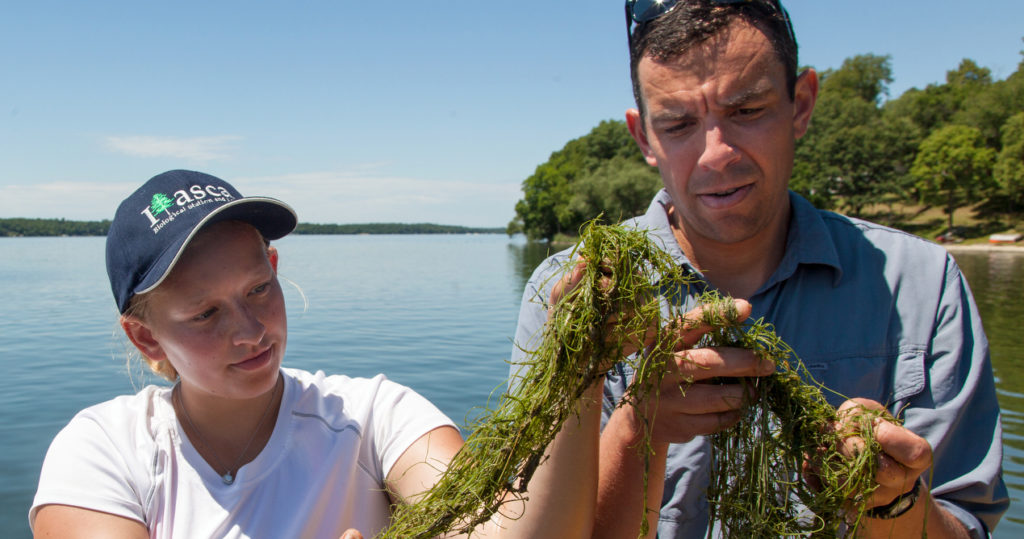
“Endangered” Starry Stonewort Loves Minnesota
Endangered in its native habitat, invasive starry stonewort finds ideal conditions to thrive in Minnesota lakes. Tough break for Minnesota.
Starry stonewort (Nitellopsis obtusa) is a new aquatic invasive species in Minnesota. This green alga—native to Europe and Asia—was first identified in Minnesota in summer 2015 in Lake Koronis (Stearns Co.). This came on the heels of new state records within the last few years in Pennsylvania, Indiana, Wisconsin, and Vermont. Its history in North America dates back to at least 1974, when it was collected from the St. Lawrence River, where it was likely introduced by transatlantic shipping. Despite its reputation as an aggressive invasive species, starry stonewort is actually classified as threatened and endangered in parts of its native range. But it has found conditions in North American lakes in which it thrives.
There are now known populations of starry stonewort in 11 Minnesota lakes, including the large, popular lakes Upper Red, Winnibigoshish, and Cass. It is likely that additional populations are already established but yet to be discovered . So far, only male starry stonewort has been observed in North America, indicating that spread here is asexual or “clonal” —via fragments and star-shaped structures called “bulbils” that give the species its name—rather than through sexual reproduction. In addition, known populations are concentrated in lakes with high use, often near boat accesses, implicating boater movement as the major means of spread.
What does the arrival of this new aquatic invasive species mean for Minnesota’s lakes? There has been little research on the ecology, impacts, and management of starry stonewort. Thus we are in a stage of high uncertainty about its true distribution, the risk that it poses, and how to best respond. But there are several reasons for vigilance. For one, it has become widespread in states where it is longer-established, particularly New York and Michigan. Nuisance growth of starry stonewort that can interfere with recreation has been observed in several lakes. There is also some evidence of ecological impacts to native plant communities. Finally, there are no known cases where starry stonewort has been eradicated, and control efforts are expensive and likely to provide only limited relief.
At the University of Minnesota, we are addressing starry stonewort on several fronts. Through research supported by the Minnesota Aquatic Invasive Species Research Center (MAISRC), we are mapping invasion risk for Minnesota lakes based on water chemistry—trying to predict which lakes may be most vulnerable to invasion based on environmental suitability. We are also testing how long starry stonewort can remain viable out of water to understand spread risk from boater movement. In addition, research in the field and lab is being performed to evaluate effectiveness of different treatment options for starry stonewort control. Finally, in a new project funded by the Minnesota Department of Natural Resources, we will be evaluating the impacts of starry stonewort invasion on native aquatic plant communities.
Starry stonewort is also a target for Extension programs addressing aquatic invasive species in Minnesota. Through the AIS Detectors program, which launched in spring 2017, citizen scientists are being trained to identify starry stonewort—and 10 other aquatic invasive plant and animal species—so that they can help identify new infestations. So far, 121 participants have completed online and in-person trainings and demonstrated proficiency to become certified AIS Detectors.
We further expanded our detection network with “Starry Trek,” a statewide search effort for new starry stonewort populations. On Saturday, August 5, 2017, over 200 volunteers gathered at 20 rendezvous locations throughout the state, received training in how to implement a search protocol for starry stonewort, and were sent out to search public accesses on 178 lakes. Volunteers in Stearns County identified what was then the tenth known population of starry stonewort (on Grand Lake), enabling a rapid response control effort. A parallel search effort led by collaborators in Wisconsin—AIS Snapshot Day—was conducted the same day. In 2018, we will again partner for a two-state invasive species search effort.
If you are interested in learning more about aquatic invasive species and contributing to Minnesota’s response, please visit www.aisdetectors.org.
[Adapted from an article by Dan Larkin, Assistant Professor & Extension Specialist, Fisheries, Wildlife, and Conservation Biology and Minnesota Aquatic Invasive Species Research Center. Photo credit MAISRC.]
[For more information about AIS prevention efforts at Lake Vermilion, contact Jeff Lovgren, AIS prevention program leader.]
Read eVermilion